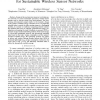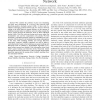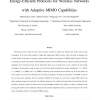132
click to vote
INFOCOM
2012
IEEE
13 years 3 months ago
2012
IEEE
Abstract—The WiFi radio in smartphones consumes a significant portion of energy when active. To reduce the energy consumption, the Power Saving Mode was standardized in IEEE 802...
206
click to vote
INFOCOM
2012
IEEE
13 years 3 months ago
2012
IEEE
Abstract—Energy is the most precious resource in wireless sensor networks. To ensure sustainable operations, wireless sensor systems need to harvest energy from environments. The...
129
click to vote
INFOCOM
2012
IEEE
13 years 3 months ago
2012
IEEE
—This paper proposes LBA, a lifetime balanced data aggregation scheme for asynchronous and duty cycle sensor networks under an application-specific requirement of end-to-end dat...
157
click to vote
PERVASIVE
2011
Springer
14 years 3 months ago
2011
Springer
Most utility installed energy meters are primarily intended to support a utility's billing function. They report only the aggregate energy consumption of a home or business o...
108
click to vote
CISS
2010
IEEE
14 years 4 months ago
2010
IEEE
—We consider the problem of joint rate scheduling and lossy data compression in a two-way relay network with distortion-sensitive stochastic packet traffic. A relay node facilit...
141
click to vote
IS
2011
14 years 4 months ago
2011
In this paper we present algorithms for building and maintaining efficient collection trees that provide the conduit to disseminate data required for processing monitoring queries...
113
click to vote
WINET
2010
14 years 7 months ago
2010
Transmission power control has been used in wireless networks to improve the channel reuse and/or reduce energy consumption. It has been mainly applied to single-input single-outp...
124
click to vote
TWC
2010
14 years 7 months ago
2010
Abstract--Impulse Radio Ultra WideBand (IR-UWB) communication has proven to be an important technique for supporting high-rate, short-range, and low-power communication. In this pa...
136
click to vote
TPDS
2010
14 years 7 months ago
2010
The basic operation in such a network is the systematic gathering (with or without in-network aggregation) and transmitting of sensed data to a base station for further processing....
147
Voted
TMC
2010
14 years 7 months ago
2010
Emerging dual-mode phones incorporate a Wireless LAN (WLAN) interface along with the traditional cellular interface. The additional benefits of the WLAN interface are, however, lik...









